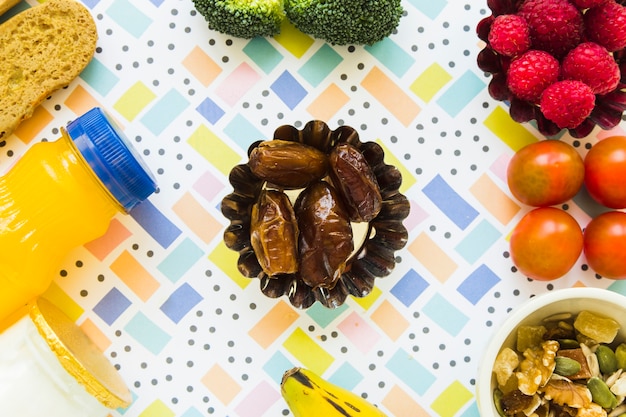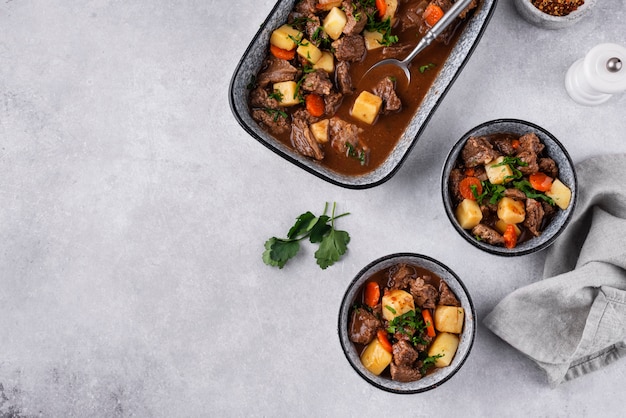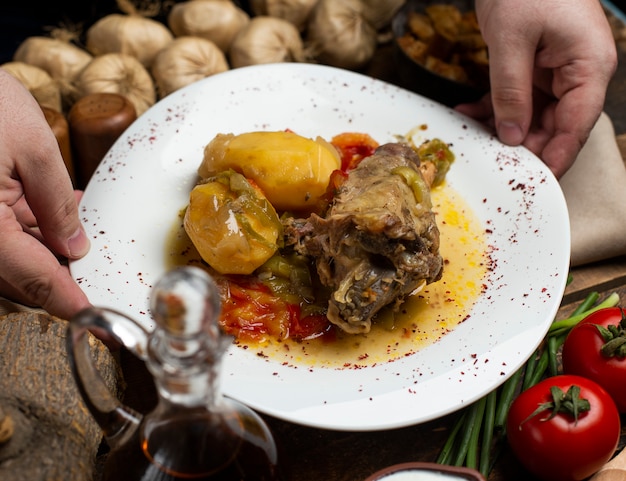Let's talk oxtail. I know, I know, it's not exactly the most glamorous cut of meat, but trust me, once you've had it cooked right, you'll be singing its praises. It's a hidden gem in the culinary world, offering a depth of flavour and tenderness that's simply unmatched. I've been cooking for years, and oxtail is one of those dishes that always impresses. It's the kind of thing that makes people ask for seconds, and then thirds, and then start asking for the recipe. It’s a real crowd-pleaser, I tell you!
Now, I understand if you're hesitant. "Oxtail? That sounds a bit… off-putting," you might think. But honestly, it's worth giving it a go. It's got a deep, rich flavour that's almost impossible to replicate with other cuts of meat. Plus, once it's slow-cooked, it literally falls off the bone, making it super easy to eat. I'm talking melt-in-your-mouth deliciousness. It's like a flavour explosion in every bite, and it's not just about the taste – it's an experience, a culinary journey you won't forget.
So, how do you make this magical dish? Well, that's what we're here for. This is your ultimate guide to cooking the most tender, flavorful oxtails. We'll go through everything from choosing the right ingredients to mastering the perfect cooking technique. You'll be a pro in no time, I promise.
(Part 1) The Art of Choosing Oxtails

Alright, first things first. You need to get your hands on some good quality oxtails. Now, this is where things can get a bit tricky. Not every butcher carries oxtail, so you might need to do a bit of digging. But don't worry, it's worth the effort. You'll be rewarded with a truly exceptional dish.
The Importance of Freshness
When choosing oxtails, freshness is paramount. Look for oxtails that are bright red, with a good amount of marbling. This means the meat is fresh and will have plenty of flavour. Marbling, those little streaks of fat, adds richness and tenderness to the meat. Avoid any oxtails that look pale or discoloured, and definitely give a wide berth to any that smell off. I've had a few experiences with bad oxtail, and let me tell you, it's a recipe for disaster. Trust your nose! It’ll tell you if something’s gone bad.
choosing the right cut
There are different cuts of oxtail, but generally speaking, they're all pretty good. However, if you can, try to choose oxtails with a good amount of meat on them. You want those juicy, flavorful chunks, not just a bunch of bones. I usually ask the butcher for their recommendations, and they’re usually happy to point me in the right direction. They're the experts, after all!
Storage and Preparation
Once you’ve got your oxtails, it’s important to store them properly. If you’re not using them immediately, pop them in the fridge for a couple of days, or you can freeze them for up to 3 months. Just make sure to wrap them tightly in plastic wrap or aluminum foil to prevent freezer burn.
Now, when it’s time to cook, you want to give your oxtails a little bit of TLC. First, rinse them off under cold water and pat them dry with some kitchen paper. This removes any excess debris and helps to create a nice, even browning when you cook them. Next, you can trim away any excess fat. Don’t be too zealous, though, as some fat is good for flavour.
(Part 2) Building the Perfect Flavour Base

Alright, so now you’ve got your oxtails ready to go. The next step is to build a flavour base that will infuse every inch of those delicious bones. We're talking about a symphony of aromas and flavours that will make your mouth water. I’m serious, this is where the magic really happens. It’s the foundation for an unforgettable oxtail experience.
The Importance of Aromatics
It all starts with the aromatics. Think of them as the backbone of your dish. You’ll need onions, garlic, and ginger. These are essential for building a rich, complex flavour profile. The onions add sweetness and depth, the garlic provides a pungent aroma, and the ginger brings a warm, slightly spicy note. You can even add a bit of celery and carrots to the mix if you’re feeling fancy. These vegetables contribute a subtle sweetness and earthiness to the dish. The key here is to sweat them in a bit of oil, slowly bringing out their natural flavours. You can add a bit of salt and pepper to taste as well, but remember, we'll be adding more later, so don’t go overboard.
Adding Spice and Depth
Now, it’s time to add a little kick to your flavour base. I’m a big fan of adding a bit of cayenne pepper, paprika, cumin, and coriander. You can also experiment with other spices, like thyme, rosemary, or bay leaves. You can get really creative here, adding your favourite spices and herbs. Just remember to start with a small amount and adjust to your taste. It’s always easier to add more than to take it out.
Cayenne pepper brings a subtle heat, paprika adds a smoky depth, cumin offers earthy notes, and coriander provides a citrusy flavour. Each spice contributes to a unique and delicious flavour profile.
The Importance of Stock
Finally, you’ll need some good quality stock. I usually use beef stock, but you can also use chicken or vegetable stock, or even water if you’re in a pinch. The stock will help to create a rich, saucy base for your oxtails. Just pour enough to cover the oxtails, and you're good to go.
Good quality stock makes a huge difference. It adds a depth of flavour that you won’t get with just water. Look for stocks that are made with natural ingredients, without any artificial flavours or preservatives.
(Part 3) The Art of slow cooking

Right, so your flavour base is simmering away, and your oxtails are prepped and ready to go. Now comes the most important part: the slow cooking process. This is where patience and a little bit of magic come into play. It’s the key to transforming those tough little pieces of meat into meltingly soft, flavorful goodness.
The Power of Slow Cooking
The beauty of slow cooking oxtails is that it allows the meat to break down and become incredibly tender. The long, slow cooking process also allows all the flavours to meld together, creating a symphony of taste that will knock your socks off.
Techniques for Slow Cooking
There are a few ways to slow cook your oxtails. You can use a slow cooker, a dutch oven, or even a pressure cooker. I prefer to use a Dutch oven, as it allows for even heat distribution and a nice, slow simmer. It also creates a beautiful, rich, and thick sauce that coats the oxtails perfectly. But, if you don’t have a Dutch oven, a slow cooker will work just fine. It's a great option for a hands-off cooking method.
If you’re using a pressure cooker, you can cook your oxtails in a fraction of the time. However, the flavour and tenderness might not be as pronounced as with a slow cooker or a Dutch oven.
The Importance of Patience
The key here is patience. Don’t rush the process. I usually cook my oxtails for 3-4 hours on low heat. This gives the meat plenty of time to break down and become super tender.
Now, here’s a little trick. After about 2 hours of cooking, give your oxtails a little flip. This will ensure that they cook evenly on all sides. If you’re using a Dutch oven, you can also add a lid to trap in all the moisture and flavour. This helps to create a rich and flavorful sauce that coats the oxtails perfectly.
Checking for Doneness
How do you know when your oxtails are done? Well, you can use a fork to see if the meat falls off the bone easily. If it does, then you're good to go. If not, just give it a little more time in the oven. Don’t worry, it’ll get there eventually. Trust me.
You can also check the internal temperature of the meat. The internal temperature of cooked oxtails should be at least 165 degrees Fahrenheit (74 degrees Celsius).
(Part 4) The Finishing Touches
Okay, so your oxtails are cooked to perfection. The meat is melting in your mouth, and the sauce is thick and rich. But there are still a few things you can do to take your dish to the next level.
The Magic of a Glaze
One of my favourite finishing touches is to add a glaze. I usually make a quick glaze by mixing a tablespoon of honey, a tablespoon of soy sauce, and a teaspoon of Dijon mustard. You can also add a bit of red wine vinegar or Worcestershire sauce for extra flavour. I’ll brush this over the oxtails in the last 30 minutes of cooking. This gives them a beautiful sheen and an extra layer of flavour. It’s a simple yet effective way to add a touch of sweetness and tanginess to the dish.
The Perfect Garnish
Finally, you’ll need a garnish to add a pop of colour and freshness. A sprinkling of chopped parsley or coriander is always nice. You can also add a squeeze of lemon juice for a little tang. A pinch of chopped chives or a few sprigs of rosemary add a visual appeal and enhance the aroma of the dish. If you’re feeling adventurous, try adding a few roasted peppers or some chopped onions. It’s all about personal preference.
The Importance of Resting
Once you’ve finished cooking your oxtails, let them rest for a few minutes before serving. This will allow the juices to redistribute and make the meat even more tender. You can also skim off any excess fat from the sauce at this stage, although I prefer to leave it in, as it adds to the richness of the dish.
(Part 5) Serving Your Masterpiece
Finally, it’s time to serve up your masterpiece. You’ve put in the effort, and now it’s time to enjoy the fruits of your labor.
Choosing the Right Accompaniments
You can serve your oxtails with a variety of accompaniments. I love serving them with a simple side of mashed potatoes or rice. These creamy and comforting sides provide a perfect contrast to the rich and savory oxtails. A green salad is also a nice way to cut through the richness of the dish. You can even make a gravy from the cooking liquid by straining it and thickening it with cornstarch or flour.
Presentation Tips
When it comes to presentation, you can get as fancy as you like. You can use a platter to serve your oxtails or arrange them individually in bowls. I like to add a few sprigs of parsley for a pop of colour. A sprinkle of chopped chives or a few slices of roasted red pepper add a vibrant visual contrast. You can also serve the oxtails on a bed of creamy polenta or a sprinkle of toasted breadcrumbs for added texture.
(Part 6) Oxtail Soup: A Warm and Comforting Classic
Of course, oxtails aren’t just delicious as a main course. They’re also a great ingredient for soup. And, trust me, oxtail soup is a real winner. It’s warm, comforting, and perfect for a chilly winter’s day. It’s the ultimate comfort food, satisfying and soul-warming.
The Basic Recipe
To make oxtail soup, you’ll need to follow a similar process to cooking oxtails as a main course. You’ll need to brown your oxtails in a pot, add your aromatics, and then simmer everything in stock for a few hours. Once the meat is tender, you can remove the bones and shred the meat. Then, simply add your favourite vegetables, like carrots, potatoes, and celery. Simmer for another 30 minutes, and you’re good to go. You can also add a few herbs, like thyme or rosemary, for a deeper flavour.
Variations and Enhancements
There are endless variations on oxtail soup. You can add different vegetables, like beans, lentils, or peas. You can also add herbs and spices to taste. A touch of paprika, a pinch of cumin, or a sprinkle of cayenne pepper can add a unique twist to your soup. If you’re feeling adventurous, try adding a dollop of sour cream or a sprinkle of grated cheese on top.
You can also add a splash of red wine vinegar or a few drops of hot sauce for a tangy kick. Don’t be afraid to experiment and create your own signature oxtail soup.
(Part 7) Exploring Other Oxtail Dishes
Beyond the traditional stew and soup, you can also explore other creative ways to use oxtail. There’s a whole world of possibilities out there, just waiting to be discovered. It’s a versatile ingredient that can be incorporated into a variety of cuisines.
oxtail tacos
For a Mexican-inspired twist, try making oxtail tacos. Simply shred the cooked oxtail and fill your tacos with the meat, salsa, and your favorite toppings. It's a flavor explosion in every bite! You can add a dollop of sour cream, a sprinkle of cilantro, or some diced onions for extra flavour and texture.
Oxtail Curry
If you're a fan of Indian cuisine, try a delicious oxtail curry. The richness of the meat blends beautifully with aromatic spices like turmeric, cumin, and coriander. You can use coconut milk to create a creamy and flavorful curry sauce. It’s a dish that’s both comforting and satisfying.
Oxtail Pasta
For a more elegant dish, try incorporating oxtail into a hearty pasta dish. You can make a sauce with the braising liquid or use the shredded meat to create a flavorful ragù. You can also add a touch of cream or Parmesan cheese to the sauce for richness and complexity. Serve it with your favorite pasta, like pappardelle or tagliatelle.
(Part 8) FAQs: Oxtail Cooking Demystified
I know, I know. You're probably thinking, “This is all great, but what about all those questions?” Fear not, fellow cooking enthusiast, because I’m here to answer all your burning questions about oxtail.
What if my oxtails are still tough?
Can I use frozen oxtails?
How do I know if my oxtails are done?
Can I make oxtail in a pressure cooker?
What are some other great ways to cook oxtails?
What if my oxtails are still tough?
Can I use frozen oxtails?
How do I know if my oxtails are done?
Can I make oxtail in a pressure cooker?
What are some other great ways to cook oxtails?
| Question | Answer |
|---|---|
| What if my oxtails are still tough? | Don't worry, it happens! If your oxtails are still tough after 4 hours of slow cooking, just give them a little more time. They'll eventually break down and become tender. You can also add a little more liquid to the pot if it starts to dry out. |
| Can I use frozen oxtails? | Absolutely! Just make sure to thaw them completely before cooking. You can thaw them in the fridge overnight or by placing them in a bowl of cold water. |
| How do I know if my oxtails are done? | The best way to tell if your oxtails are done is to use a fork to see if the meat falls off the bone easily. If it does, then you're good to go. If not, just give them a little more time in the oven. You can also check the internal temperature of the meat. The internal temperature of cooked oxtails should be at least 165 degrees Fahrenheit (74 degrees Celsius). |
| Can I make oxtail in a pressure cooker? | Yes, you can! Cooking oxtails in a pressure cooker will cut down on the cooking time significantly. Just make sure to follow the manufacturer's instructions for your specific pressure cooker. However, the flavour and tenderness might not be as pronounced as with a slow cooker or a Dutch oven. |
| What are some other great ways to cook oxtails? | There are endless possibilities! You can make oxtail tacos, oxtail curry, oxtail pasta, or even oxtail stir-fry. Get creative and have fun with it! |
(Part 9) Final Thoughts
And there you have it! Your ultimate guide to cooking the most tender, flavorful oxtails. I hope this has inspired you to give this wonderful cut of meat a try. It’s truly a hidden gem, and once you discover its deliciousness, you’ll be hooked for life. Remember, don’t be afraid to experiment and have fun in the kitchen. You never know what culinary masterpiece you might create.
So, go forth and conquer the world of oxtail! And, if you have any questions or tips to share, feel free to leave a comment below. Happy cooking!
Everyone is watching

Prime Rib Roast Cooking Time Chart: Per Pound Guide
Cooking TipsPrime rib roast. Just the name conjures images of lavish dinners, crackling fires, and hearty laughter. It’s ...

How Long to Bake Potatoes in the Oven (Perfect Every Time)
Cooking TipsBaked potatoes are a staple in my kitchen. They're incredibly versatile, delicious, and surprisingly easy to m...

Perfect Rice Every Time: The Ultimate Guide to Cooking Rice
Cooking TipsAs a self-proclaimed foodie, I've always been a bit obsessed with rice. It's the foundation of countless cuisi...

The Ultimate Guide to Cooking Asparagus: Tips, Techniques, and Recipes
Cooking TipsAsparagus. The mere mention of this spring delicacy conjures up images of vibrant green spears, crisp and burs...

Ultimate Guide to Cooking the Perfect Thanksgiving Turkey
Cooking TipsThanksgiving. Just the word conjures up images of overflowing tables laden with delicious food, the scent of r...
